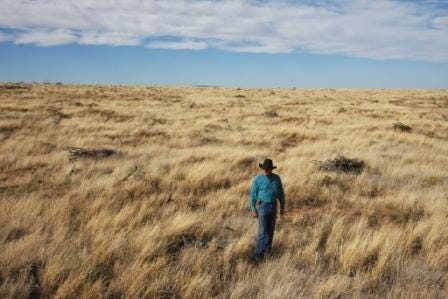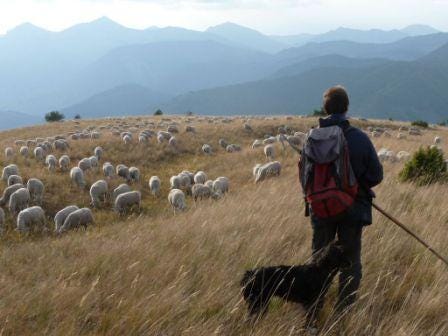Welcome to Terra Firma by Courtney White. I’ve spent my life prospecting for innovative, practical, and collaborative answers to pressing problems involving land and people, sharing them with others. I’d like to share them with you!
Don’t miss the next issue, sign up here:
I’d like to take a moment and thank everyone for signing up for this newsletter. What began last November as a leap-of-faith (will anyone want to read this stuff?) with just a few subscribers has grown into a substantial project with many readers! That’s encouraging and I greatly appreciate your support.
News Item: Have you heard about the “farm-free food” movement? Its advocates say lab-made synthetic food must replace real food in order to fight climate change. Seriously! This crazy idea got a big boost recently from a prominent environmental columnist in England. Here’s a counter-argument by Twilight Greenaway this week in Civil Eats (see). It relates to my story below and I’ll be writing on this topic later.
In the two previous issues of Terra Firma, I discussed the concept of a carbon ranch, which can sequester atmospheric carbon dioxide in soils thanks to regenerative land management practices, as well as healthy soil legislative initiatives around the nation. Both are part of a hopeful regeneration movement taking place today centered on land, food, and people (see TF#1).
In this issue, I’d like to switch gears away from science, policy, and movements. I’d like to tell a story instead. In fact, I’ve come to believe that story-telling is the missing link in our collective efforts to meet rising challenges in the world. We have LOTS of data and best-management practices to work with (though we still need more) but what we lack are inspiring stories to communicate this information in effective ways.
In this issue, I’d like to share a story about ranchers Tom and Mimi Sidwell and their JX Ranch, who exemplify much of what I have been discussing in Terra Firma. It’s a tale I’ve told before, but I would like share it again here.

In 2004, cattle ranchers Tom and Mimi Sidwell bought the 7,000-acre JX Ranch, south of Tucumcari, New Mexico, and set about doing what they know best: earning a profit by restoring the land to health and stewarding it sustainably.
As with many ranches in the arid Southwest, the JX had been hard used over the decades. Poor land management had caused the grass cover to diminish in quantity and quality, exposing soil to the erosive effects of wind, rain, and sunlight which also eroded the carbon content of the soil significantly. Gullies had formed across the ranch, small at first, but growing larger with each thundershower, cutting down through the soft soil, biting into the land deeper, eating away at its vitality. Water tables fell correspondingly, starving plants and animals alike of precious nutrients, forage, and energy.
Profits fell too for the ranch’s previous owners. They had followed a time-honored business plan: stretch the land’s ecological capacity to the limit, add more cattle whenever possible, and pray for rain when dry times arrived, as they always did. The result was the same: a downward spiral as the ranch crossed ecological and economic thresholds. In the case of the JX, the water, nutrient, mineral, and energy cycles unraveled across the ranch causing the land to disassemble and eventually fall apart.
Enter the Sidwells. With thirty years of experience in progressive ranching, they saw the deteriorated condition of the JX not as a liability but as an opportunity. Tom began by dividing the entire ranch into sixteen pastures, up from the original five, using solar-powered electric fencing. After installing a water system to feed all sixteen pastures, he picked cattle that could do well in dry country, grouped them into one herd and set about rotating them through the pastures, never grazing a single pasture for more than 7-10 days in order to give the land plenty of recovery time.
Next, he began clearing out the juniper and mesquite trees on the ranch with a bulldozer, which allowed native grasses and forbs to come back. As grass returned, Tom lengthened the period of rest between pulses of cattle grazing in each pasture from 60 days to 105 days across the whole ranch. More rest meant more grass, which meant Tom could graze more cattle – to stimulate more grass production. In fact, Tom increased the overall livestock capacity of the JX by twenty-five percent in only six years, significantly improving the ranch’s bottom line.
Here’s a photo I took of Tom standing on the restored grasslands of the JX:

Another positive impact of their management was on the carbon cycle. By growing grass on previously bare soil, by extending plant roots deeper, and by increasing plant diversity and vitality – all as a result of good stewardship – the Sidwells sequestered more CO2 in the ranch’s soil than the previous owners had.
In other words, if bare, degraded, or unstable land can be restored to a healthy condition with properly functioning carbon, water, mineral, and nutrient cycles and covered in green plants with deep roots, then the quantity of CO2 that can be sequestered is potentially high.
There’s another benefit to carbon-rich soil: it improves water infiltration and storage due to its sponge-like quality. Research indicates that one part carbon-rich soil can retain as much as four parts water. This has important positive consequences for the recharge of aquifers and base flows to rivers and streams which are the life-bloods of cities.
It’s also important to people who make their living off the land, as Tom and Mimi Sidwell can tell you. They were pleased to discover that a spring near their house had come back to life. For years, it had flowed at a miserly rate of ¼ gallon-per-minute, but after clearing out the juniper trees above the spring and managing the cattle for increased grass cover, the well began to pump 1.5 gallons a minute 24 hours a day!
In fact, the water cycle has improved all over the ranch, a consequence of water infiltrating down into the soil now because of the grass cover, rather than sheeting off erosively as it had before. This is good news for microbes, insects, grasses, shrubs, trees, birds, herbivores, carnivores, cattle, and people. Here’s Tom and Mimi:

In harmony with their land management goals, the Sidwells converted their beef business to an entirely grassfed, direct-marketed operation. Grassfed means the animals have spent their entire lives on grass – which is what nature intended for them. As an added-value food, grassfed meat can fetch a higher price than conventional meat – if customers are willing to pay for it, which in the Sidwells’ case they are. This extra profit has helped the Sidwells significantly.
What Tom and Mimi did on the JX is reassemble the carbon landscape. They reconnected soil, water, plants, sunlight, food and profit in a way that is both healing and sustainable. They did it by reviving the carbon cycle as a life-giving element on their ranch, and by returning to nature’s principles of herbivory, ecological disturbance, soil formation, microbial action, and good food. In the process, they improved the resilience of the land and their business for whatever shock or surprise the future may have in store.
Resources:
Here is an article by soil scientist Christine Jones (from the Quivira Journal) about soil, agriculture, and climate in Australia that is prescient given the tragic fires taking place on the continent right now: https://www.amazingcarbon.com/PDF/Jones-AdaptingFarming-Quivira%20(Feb10).pdf
Here’s a story about a carbon ranch in California: https://www.leonardodicaprio.org/farming-for-carbon-why-farmers-are-key-to-fighting-climate-change/
Here’s a newspaper story also from California: https://www.sandiegouniontribune.com/communities/north-county/sd-no-carbon-farming-20170512-story.html
Water-holding capacity of soils:
https://www.nrdc.org/experts/lara-bryant/organic-matter-can-improve-your-soils-water-holding-capacity
Here’s a brief discussion of soil carbon and its benefits from the USDA/NRCS: https://www.nrcs.usda.gov/wps/portal/nrcs/detailfull/soils/health/mgnt/?cid=nrcs142p2_053859
https://www.agriculture.com/crops/cover-crops/hold-water-in-the-soil
Video:
Tom Sidwell gave an hour-long presentation on his ranching practices, including how to survive a bad drought (as they did), at the 2013 Quivira Coalition conference (see).
Range scientist Richard Teague gave an hour presentation titled “A Scientific Perspective on Managing Grazing Ecosystems in a Warming World” at the 2015 Quivira conference (see).
Here is Allan Savory’s famous 22-minute TED talk on reversing desertification. If you haven’t seen it, definitely take a look (see).
A six-minute video by the NRCS on different grazing management practices and water infiltration rates in soil (see).
A 1-minute video of soil evangelist Ray Archuleta (formerly with the NRCS) of his famous slake test (see).
Web Sites:
JX Ranch: https://leannaturalbeef.com/
Savory Institute: https://www.savory.global/
Holistic Management International: https://holisticmanagement.org/
USDA / NRCS soil health site: https://www.nrcs.usda.gov/wps/portal/nrcs/main/national/soils/health/

COURTNEY’S CORNER
~ The original story I wrote about the JX Ranch was published in Acres magazine (2011) and focused on the delivery of ecosystems services, described in detail: http://jcourtneywhite.com/wp-content/uploads/2016/09/Walking_the_Talk.pdf
~ Latest book: Fibershed: Growing a Movement of Farmers, Fashion Activists, and Makers for a New Textile Economy by Rebecca Burgess and yours truly, 2019, https://www.chelseagreen.com/product/fibershed/
~ Here’s my pick for the Terra Firma photo of the week - Herding in the French Alps (courtesy of Michel Meuret):

Thank you for reading this issue of my newsletter. It is published every Thursday morning – for free! Please consider sharing it with a friend or two or three:
About me: For twenty years I worked to create a radical center among ranchers, conservationists, agencies and others focused on western working landscapes. Today, I am a full-time writer. My nonfiction books include Forewords by Wendell Berry and Michael Pollan. For more information or to contact me visit: www.jcourtneywhite.com
I am also the author of a MYSTERY novel called The Sun. It is a modern-day story set on a working cattle ranch in northern New Mexico (see). To purchase a copy go here. Here’s an endorsement from Anne Hillerman, New York Times best-selling author of the Leaphorn/Chee/Manuelito mysteries:
“In this far-ranging debut novel, Courtney White creates a story worthy of his deep and detailed knowledge of the American West today. Nicely done!”
Terra Firma means ‘solid earth’ or ‘firm ground’ in contrast to air or water. Historically, it was first used by the Republic of Venice to describe its holdings on the Italian mainland.


